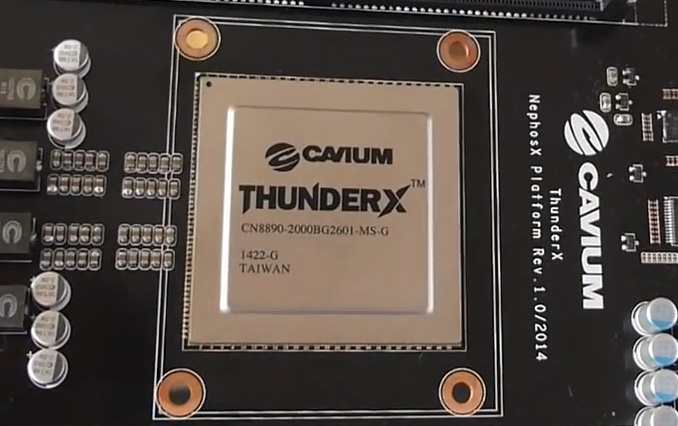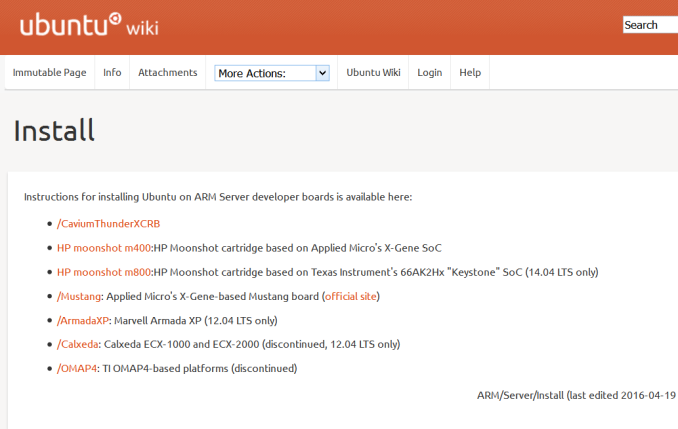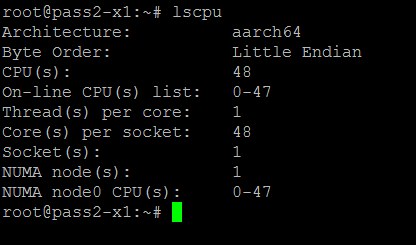Investigating Cavium's ThunderX: The First ARM Server SoC With Ambition
by Johan De Gelas on June 15, 2016 8:00 AM EST- Posted in
- SoCs
- IT Computing
- Enterprise
- Enterprise CPUs
- Microserver
- Cavium

When is a worthy alternative to Intel's Xeon finally going to appear? That is the burning question in the server world. If PowerPoint presentations from various ARM-based SoCs designers released earlier this decade were to be believed, Intel would now be fighting desperately to keep a foothold in the low end server market. But the ARM SoCs so far have always disappointed: the Opteron A1100 was too late, the X-Gene 1 performed poorly, consumed too much power, and Broadcomm's Vulcan project is most likely dead. This Ubuntu page is an excellent illustration of the current state of the ARM server market:
Discontinued products, many announced products which do not even appear on this page (we are in the middle of 2016, after all), and despite the fact that there is an ARM Server Base System Architecture (SBSA) specification, every vendor has its own installation procedure. It is still a somewhat chaotic scene.
Meanwhile, Intel listened to their "hyperscaler customers" (Facebook, Google...) and delivered the Xeon D. We reviewed Intel's Broadwell SoC and we had to conclude that this was one of the best products that Intel made in years. It is set a new performance per watt standard and integrated a lot of I/O. The market agreed: Facebook's new web farms were built upon this new platform, ARM servers SoCs were only successful in the (low end) storage server world. To make matter worse, Intel expanded the Xeon D line with even higher performing 12 and 16 core models.
But losing a battle does not mean you lose the war. Finally, we have a working and available ARM server SoC which has more ambition than beating the old Atom C2000 SoC. In fact, Cavium's ThunderX SoC has been shipping since last year, but you need more than silicon to get a fully working server. Firmware and kernel need to get along, and most libraries need to be compiled with platform-specific optimizations. So the quality assurance teams had a lot of work to do before Cavium could ship a server that could actually run some server software in a production environment. But that work has finally been finished. Cavium send us the Gigabyte R120-T30 running Ubuntu 14.04 server with a ThunderX ready Linux kernel (4.2.0) and ThunderX optimized tools (gcc 5.2.0 etc.).
Cavium?
Who is Cavium anyway? Even for those working in the enterprise IT, it is not a well known semiconductor company. Still, Cavium has proven itself as fabless network/security/storage and video SoC designing company. The company based in San José counts IBM, Juniper, Qualcomm, Netgear, Cisco among its customers.
With a net revenue of about $400 million, Cavium is about one-tenth the size of AMD. But then again, Cavium either reports small losses or smal profits despite heavy investments in the new ARMv8 project ThunderX. In other words, the company's financials look healthy. And Cavium did already design a 16-core MIPS64 Octeon Network Service Processor (NSP) back in 2006. So Cavium does have a lot of experience with high core count SoCs: the network processor Octeon III CN78xx has 48 of them.
Handling server applications is of course very different from network processing. A large amount of independent network packets creates a lot of parallelism, and more complex computation can be offloaded to co-processors. Still, Cavium is the first vendor that delivers an ARMv8 server chip with an impressive core count: no less than 48 cores can be found inside the ThunderX die.
To keep the design effort reasonable, Cavium based their first ARMv8 server processor, ThunderX, on the Octeon III CN78xx. We described this in more detail here, but the main trade-off is that Cavium used a relatively simple dual issue core. As a result, single threaded performance is expected to be relatively low. On the opposite side of the coin however, it is the first ARM SoC that has claimed throughput numbers in the realm of the best Xeon D and even midrange Xeon E5, instead of competing with the Atom C2000. It is the most ambitious ARMv8 SoC that has made it into production.
All of this gives us plenty of reasons to put the Cavium ThunderX through paces. And throwing in the latest Supermicro boards with the latest 12 and 16 core Xeon-Ds made it a lot more interesting ...












82 Comments
View All Comments
TheinsanegamerN - Thursday, June 16, 2016 - link
While you are right on the actual age of the chip, if you dont compare efficiency on different nodes, how on earth would you know if you made any progress?Unless you are suggesting that one should never compare one generation of chips to another, which is simply ludicrous. Where is this "you cane compare two different nodes" mindset coming from? I've seen it in the GPU forums as well, and it makes no sense.
shelbystripes - Wednesday, June 15, 2016 - link
The E5-2600 v3 is a Haswell part, meaning it's Intel's second ("tock") core design on 22nm. So not only is this a smaller process, it's a second-gen optimization on a smaller process.For a first-gen 28nm part that includes power-hungry features like multiple 10GbE, these are some very promising initial results. A 14nm die shrink should create some real improvements off the bat in terms of performance per watt, and further optimizations from there should make this thing really shine.
Given that Intel hasn't cracked 10nm at all yet, and it'll take a while for 10nm Xeons to show up once they do, Cavium has room to play catch-up. I mean, hell, they're keeping up/surpassing Xeon D in some use cases NOW, and that's a 14nm part. What Cavium needs most is power optimization at this point, and I'm sure they'll get there in time.
Michael Bay - Thursday, June 16, 2016 - link
Good to know Intel is keeping you up to date with what`s happening in their uv labs.rahvin - Thursday, June 16, 2016 - link
Last I saw Intel is already running their test fabs at 10nm. Once they perfect it in the test fabs it only takes them about 6 months to roll it into a full scale fab. Maybe you an point to this source that indicates Intel has failed at 10nm.kgardas - Wednesday, June 15, 2016 - link
Nice article, but really looking to see testing of ThunderX2 and X-Gene 3. Will be interesting as Intel seems to be kind of struggling with single-threaded performance recently...Drazick - Wednesday, June 15, 2016 - link
Just a question.You emphasized the performance are x3 instead of x5 but I bet Intel used Intel ICC for those tests.
Intel works hard on their Compilers and anyone who wants to extract the best of Intel CPU uses them as well.
Since CPU means Compilers, if Intel has advantage on that department you should show that as well.
Namely give us some results using Intel ICC.
Thank You.
UrQuan3 - Wednesday, June 15, 2016 - link
Of course, if Anandtech uses ICC, they should use better flags in gcc for ARM/ThunderX as well (core specific flags, NEON, etc). Both ICC and targeted flags give improvements. Often large ones. This was a generic test.JohanAnandtech - Thursday, June 16, 2016 - link
For integer workloads, ICC is not that much faster than gcc (See Andreas Stiller's work). And there is the fact that ICC requires licensing and other time consuming stuff. From a linux developer/administrator perspective, it is much easier just to use gcc, you simply install it from repositories, no licensing headaches and very decent performance (about 90% of icc). So tha vast majority of the **NON HPC ** software is compiled with gcc. Our added value is that we show how the processors compare with the most popular compiler on linux. That is the big difference between benchmarking to put a CPU in the best light and benchmarking to show what most people will probably experience.Until Intel makes ICC part of the typical linux ecosystem, it is not an advantage at all in most non-HPC software.
patrickjp93 - Friday, June 17, 2016 - link
His work is woefully incomplete, lacking any analysis on vectorized integer workloads, which Intel destroys GCC in to the tune of a 40% lead.phoenix_rizzen - Wednesday, June 15, 2016 - link
"The one disadvantage of all Supermicro boards remains their Java-based remote management system. It is a hassle to get it working securely (Java security is a user unfriendly mess), and it lacks some features like booting into the BIOS configuration system, which saves time."It's IPMI, you can use any IPMI client to connect to it. Once you give it an IP and password in the BIOS, you can connect to it using your IPMI client of choice. There's also a web interface that provides most of the features of their Java client (I think that uses Java as well, but just for the console).
For our SuperMicro servers, I just use ipmitool from my Linux station and have full access to the console over the network, including booting it into the BIOS, managing the power states, and even connecting to the serial console over the network.
Not sure why you'd consider a full IPMI 2.0 implementation a downside just because the default client sucks.